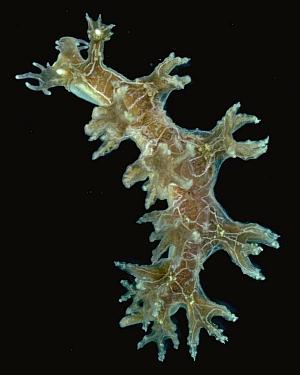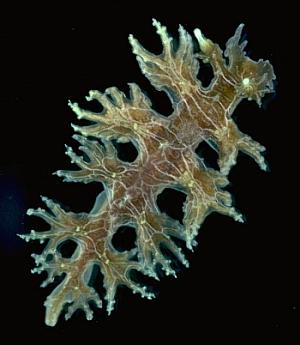

Hancockia sp. 1
Order: NUDIBRANCHIA
Suborder: DENDRONOTINA
Family: Hancockiidae
DISTRIBUTION
Known from New Caledonia and Japan
PHOTO
Lagoon between mainland and Récif de l'Infernet, off Koumac, New Caledonia, 20°34.4'S, 164°13'E, 12m, Silty bottom with dense gorgonian beds, 4 October 1993, 17mm long alive. PHOTOS: Bill Rudman.
Very few species of this distinctive genus have been described (Thompson, 1972). One species, Iduliana papillata O'Donoghue, 1932, from southern India, is probably a species of Hancockia, but the description is difficult to interpret. The only other species described from the Indo-West Pacific is H. burni Thompson, 1972, from eastern Australia. That species ranges from a pale translucent brown to a dark brown with white patching. This species from New Caledonia, is possibly a new species. It differs in being dark brown with a network of fine white lines over the dorsum and the sides of the body. Species of Hancockia are often found on brown laminarian algae and kelp, where they are well camouflaged and feed on hydroids growing on the algae.
References:
• MacFarland, F.M. (1923) The morphology of the nudibranch genus Hancockia. Journal of Morphology 38(1): 65-104, Pls 1-6.
• Thompson, T.E. (1972) Eastern Australian Dendronotoidea (Gastropoda: Opisthobranchia). Zoological Journal of the Linnean Society, 51(1): 63-77.
Rudman, W.B., 2001 (January 23) Hancockia sp. 1 [In] Sea Slug Forum. Australian Museum, Sydney. Available from http://www.seaslugforum.net/find/hancsp1
Related messages
Hancockia burni ? at Woody Point Queensland [2]
November 13, 2008
From: David Mullins

Dear Bill,
To accompany message #22025, here are some more pics of the Hancockia showing the anterior ventral features, detail of the cerata and the midline dorsal papillae.
Locality: Woody Point, Redcliffe Peninsula, Moreton Bay, intertidal, Queensland, Australia., Pacific Ocean, 09 August 2008, weed covered intertidal rocks. Length: 7 mm. Photographer: David Mullins.
Kind regards,
David Mullins
marineimages@hotmail.com



Dear David,
Thanks very much for these photos. The branched papillae [gills] down the dorsal midline are certainly very conspicuous but I assume they can retract to a small 'bump' on the skin. The rounded nodules on the 'fingers' of the cerata are quite interesting, because they contain nematocysts - the stinging cells from their food. These are interesting, because we normally think that aeolid nudibranchs are the only nudibranchs that store nematocysts [see cnidosac Fact Sheet]. In Hancockia, these nematocyst-storing nodules occur not only on the 'cerata' but also on the back, sides of body, and even on the rhinophore sheaths.
Best wishes,
Bill Rudman
Hancockia burni? at Woody Point Queensland [1]
November 13, 2008
From: David Mullins

Concerning message #3424:
Dear Bill,
I recently had the very good fortune to find the spectacular looking Hancockia burni here at Woody Point feeding on hydroids growing on the thalli of Dictyopteris sp. brown algae in the intertidal gutters.
The compound cerata are intriguing in appearance being held up like a cupped hand and carried high when on the move (might this be a defensive posture?) but spread out like finger tips balancing on a table when at rest.
Down the centreline of the dorsal surface is a line of feathery compound papillae. The rhinophoral sheath is cup shaped at its distal end and fringed with a number of papillae. A flattened lobe having finger like projections can be seen each side of the mouth with the right side on this specimen appearing to be damaged or poorly developed.
Locality: Woody Point, Redcliffe Peninsula, Moreton Bay, intertidal, Queensland, Australia., Pacific Ocean, 09 August 2008, weed covered intertidal rocks. Length: 7 mm. Photographer: David Mullins.
More pictures of specific features follow in a second message [#22027 ].
Kind regards,
David Mullins
marineimages@hotmail.com



Dear David,
Thanks for these photos of a very interesting animal. Apart from the usual curious structures found in Hancockia, in particular the hand-like 'cerata', I am intrigued by the row of distinct branched papillae - which I guess we can call gills - which form a row down the dorsal midline. I don't recall any description of such gills in this genus before, but on looking at my fieldnotes on Hancockia sp. 1 from New Caledonia, I note a row of tubercles down the midline, which could well be these branched papillae retracted.
Now to the vexed question of whether these are Hancockia burni. Thompson (1972) described that species from six 10 m long specimens he collected from Nth Stradbroke Island, sthn Queensland. So in terms of geographic locality, your animals match. Unfortunately when we look at the anatomical detail I can't find any characters which would not apply to any member of the genus. More importantly the description of the colour of the living animal is brief, but certainly doesn't fit your animals.
"The body-color was translucent white with a fine irregular pattern of reticulate brown markings and opaque white specks, giving a marbled appearance. A small minority of the white specks has a green iridescent sheen."
The distinctive opaque white pattern of lines, and the midline row of gills, are not mentioned. I wondered if the lack of colour in Thompson's animals was a result of smaller size, but his animals were if anything, slightly larger than yours. It's possible that there is one species with a very variable colour pattern, but so far we have no evidence for that. I suspect your animal is what I am calling Hancockia sp. 1. Perhaps it will prove to be a colour form of Hancockia burni, but up to now I know of no finds of animals which match Thompson's H. burni in colour.
Best wishes,
Bill Rudman
Hancockia from Izu, Japan
January 25, 2001
From: Haruo Kinoshita

Hello,
This was on Eckloniopsis radicosa which is common in Izu, Japan.
Photo: Haruo Kinoshita
Place: Izu Ocean Park, Izu Peninsula, Japan
Date: Oct 6 2000
Depth: 12m
Temperature: 19c
Length: approx. 15mm
Regards,
Haruo Kinoshita
shirara@af.airnet.ne.jp
Kinoshita, H., 2001 (Jan 25) Hancockia from Izu, Japan. [Message in] Sea Slug Forum. Australian Museum, Sydney. Available from http://www.seaslugforum.net/find/3424Dear Haruo,
This is a species of Hancockia which I am pretty sure is unnamed. From its name, I guess the Eckloniopsis radicosa you found it on is a brown alga. Species of Hancockia are often found on laminarian brown algae and kelp, because the strong flattened 'leaves' are a good place for hydroids, which Hancockia feeds on, to grow.
Best wishes,
Bill Rudman
